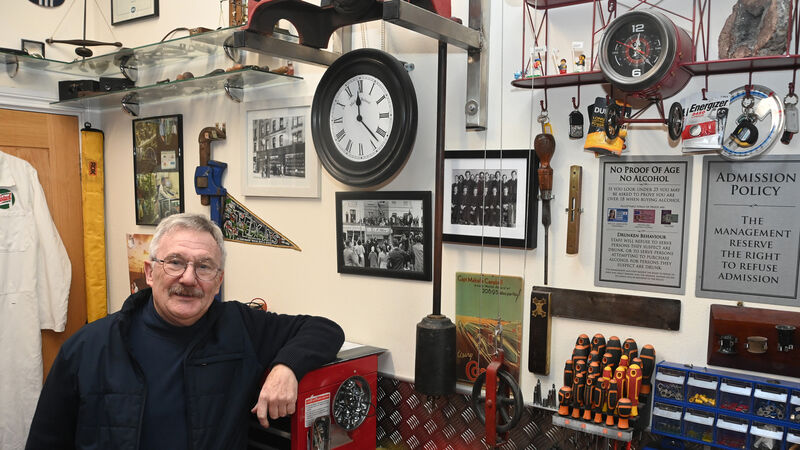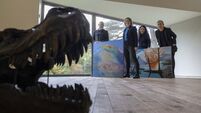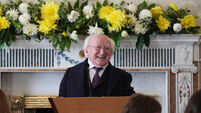Three generations of clock-making in Mick's garage!

Mick Boland in his workshop/garage/man cave. Mick's grandfather, father and brother all worked in the former Mangan Jewellers on Patrick Street and Mick has various artefacts from the shop that he’d like to see put on display somewhere. Picture: Larry Cummins
STEPPING into Mick Boland’s garage in Douglas is like stepping back in time.
Quite literally so, as the 69-year-old retired marine engineer has a treasure trove of artefacts salvaged from the renowned former James Mangan clock makers and jewellers on Patrick Street, where three generations of his family worked.
“My grandfather, my father and my brother all worked there,” Mick told .
“They had the nickname of the Father, the Son and the Holy Ghost!”
Amongst the paraphernalia Mick saved from the iconic shop, located where Merchant’s Quay shopping centre is today, are tools used by his family members, wages books, a lathe originally belonging to James Mangan himself and a decorative plate presented to Mick’s father, Wilfred Boland, for 60 years of loyal service.

But the pièce de résistance is the original mechanism for the landmark Mangan’s Clock in perfect working order.
“There was a shaft that went out through a little pipe under the ground, under the footpath, and up to the movement on the top and when you wound the clock, you wound it from the basement, it pulled a big heavyweight right up to the second story and it would run for about two weeks on that,” Mick explained.
Before Mangan’s was demolished in the 1980s to make way for the shopping centre, Mick obtained permission to save the mechanism from the shop’s basement, keen to preserve a piece of engineering he had become quite familiar with growing up.
“Every now and then, the clock would run slow and they couldn’t figure out what was happening.
“I was about 16/17 at the time and the father said we’ll sort this. They were at it for years trying to sort it.
“We went down anyway and looked at it,” Mick recalled.

“There was a bearing gone on it, a little brass bearing, and I made the bearing for it and that’s the only non-standard part that’s in it. But that wasn’t what was causing it to go slow.
“It was going slow one day and he said, ‘come on quick and we’ll have a look’.
“So we went down into the basement, we looked, tide was high, there was water in the basement and the pendulum was touching the water. That was what was causing it to go slow.”
On another occasion, Mick recounted how the staff at Mangan’s were perplexed as to why the clock was running fast, only to find that a rat had taken refuge on the clock’s pendulum when flooding had again occurred.
“The next one was it was going fast and they hadn’t a clue about that one.
“That was a very oddball one! So, same thing, ‘quick, we’ll have a look’ and the tide was coming in… and getting away from the flood and the water in the basement was a rat and he was sitting on the pendulum so the pendulum was heavier, so the clock went faster!” According to Cork City Council, Mangan's Clock has been a fixture on the city’s main street since the 1850s.
The local authority recently announced that it has commissioned Stokes Clock and Watches to carry out repair works to restore the much-admired clock to working order, much to Mick’s delight.
“I passed it on numerous occasions and I was dreading that it would be taken away or something,” he said.
Indeed, the clock serves as a prominent reminder of the popular former shop which opened its doors in 1817 and traded until the 1980s.
Mangan's craftsmen were also involved in the manufacture of the iconic ‘four faced liar clock’ in Shandon in 1847 and the original public clocks in places such as Youghal and Midleton.

Between them, Mick’s grandfather, father and brother worked in the shop for more than a century.
Mick’s grandfather, Henry, worked in Birmingham honing his craft as a jeweller before being head hunted to work in Mangan’s.
“He worked for a company called Johnson Matthey in Birmingham and he also worked for Matthew Boulton & Company Ltd, the famous Matthew Boulton of the steam engines and all that, the descendants of his – they were all silversmiths and goldsmiths.
“He did his apprenticeship there and while he was there, he invented the bolt snap and I have the very first one he made.
“He came back to Cork because Mangan’s essentially head hunted him because he was a jeweller, but he specialised at the time in spectacles and Mangan’s had an optical room,” Mick said.
“My father ended up as kind of the resident expert/manager in the shop itself. He worked in Mangan’s all his life.”
And of the many interesting stories Mick heard about the shop, perhaps the most remarkable is the night Mangan’s narrowly escaped destruction during the Burning of Cork in December 1920.
That fateful night was recounted by Mick’s father in a newspaper article in the on November 24, 1977, which Mick has in his collection.
It reads:
“’The auxiliary soldiers came into the shop,’ recalled Wilfred Boland of Capwell Avenue who was working in Mangan’s at the time, ‘and they placed a green can full of petrol near an old grandfather clock which stood near the door.

“‘Then as they left they hurled a hand grenade back into the shop. The grenade exploded but quite remarkably, it failed to set the can of petrol on fire.’”
Mr Boland went on to state that every window in the shop was broken that night on Saturday, December 11 and staff spent the whole next day cleaning up the mess before opening for business as usual on Monday.
Given the prominence and long history of Mangan’s, Mick would like to see the items he has salvaged put on public display in a new museum dedicated to the trades of Cork.
“I think there should be some place where the trades of Cork should be displayed.
“And I’m not just talking about jewellery, I’m talking about everything. Cork has a proud industrial history,” he said.
“I’m probably one of thousands of people in the city who has artefacts…. there must be someone who’s capable of putting something like that together.
“I would have thought somewhere like the old Harbour Commissions building or somewhere like that would be a spectacular site for it,” he continued.
“To me, you’re not just looking at artefacts here, you’re looking at a lifestyle.”











 App?
App?





